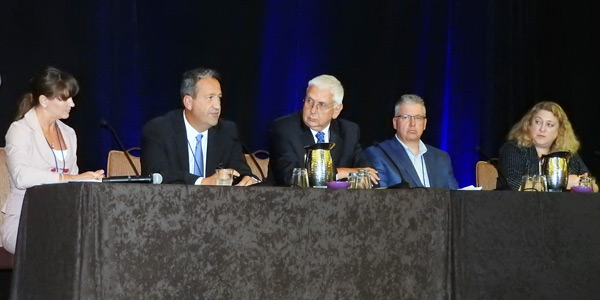By Rory D. Sweeney
BALTIMORE — PJM continued its effort to convince stakeholders of the wisdom of investing in system resilience at Tuesday’s Grid 20/20 conference.

Ott | © RTO Insider
CEO Andy Ott set the tone from the outset, promising stakeholders that the initiative would not result in unbridled spending.
“Some worry when we say the word ‘resilience,’ we need to gold-plate the system. And that’s not really anybody’s intention,” Ott said. “Does that mean we need to spend infinite amount of dollars? Of course not.”
He said staff will focus on three issues: deducing the criticality of grid assets, fuel security and quicker recovery from system failures.
“Twenty years ago, we didn’t talk about people attacking the grid. Today it’s a common discussion,” he said.

Stockton | © RTO Insider
Paul Stockton, managing director at consulting firm Sonecon and former assistant secretary of defense, used his keynote address to warn that cyberattacks are coming and that the government will be involved in the response.
“Attackers are preparing the battlefield today. … They are trying to establish a persistent presence so they can attack you at a time of their own choosing,” he said. “We need to be prepared to raise the cyber walls.”
Stockton said triggers should be developed now to establish when and how conservative operations are implemented, praising PJM for having “by far the most detailed” plan among RTOs and ISOs.
He said the industry also should plan for external reactions, such as a potential “panic in the financial markets” when media reports reveal that conservative operations have been implemented. Inaccurate news reports could spread fear and chaos, he warned.
“It doesn’t matter if it’s true. If it gets out on media enough, you’ve got a serious challenge,” he said. “Get ready for information warfare.”
He agreed with a point Ott had made earlier to “make critical facilities less critical” by building redundancies.
Attendees acknowledged the issues but challenged PJM to let its actions do the talking.
“What is your plan to engage critical stakeholders to get from where we are today to where we need to be?” Exelon’s Gloria Godson asked.

Ralph LaRossa, PSEG; second from left, speaks as moderator Chantal Hendrzak, PJM; Richard Kruse, Enbridge; John Norden, ISO-NE, and Stefanie Brand, N.J. Rate Counsel, listen. | © RTO Insider
Ott responded that PJM staff will work through the stakeholder processes and engage states through existing channels, such as the Organization of PJM States Inc. “There’s no specific one item that’s going to cover anything,” he said.
“In terms of accountability, it’s great if PJM is going to say they’re going to do everything, but that kind of takes the states off the hook,” Stockton said. “The states have to know if there are areas in cybersecurity or addressing critical facilities within their localities, that there are things that they should be doing to make sure that their utilities are in a proper state of resilience.”
Other panelists agreed with Stockton that a major hurdle is defining the cost-benefit payback of resilience upgrades.

Brand | © RTO Insider
“We don’t know the probability of the storm coming and we don’t know the probability of what kind of damage is going to result,” said Stephanie Brand, director of New Jersey’s Division of the Rate Counsel. “It is very difficult to figure out what are the measures that will bring the most bang for the buck.”
Ralph LaRossa, the president and CEO of PSEG Power, recalled his years running Public Service Electric and Gas. Customers never wanted the lights to go out, and if they did, they had to be back on within 20 minutes, he said.
Brand questioned that characterization, saying customers are more informed and understanding than that.
“There will always be some people who are just going to be complainers, but I don’t agree that the average consumer expects their lights never to go out and expects it to be back up in 20 minutes. I think they understand that it’s difficult,” she said.

LaRossa | © RTO Insider
LaRossa held up his cell phone and said customers are concerned with recharging mobile devices.
“It’s not an easy balance to make here, but if we don’t succeed at this, we’ll lose the industry. We have to figure this out together. We can’t be fighting among ourselves.”
John Norden, director of operations for ISO-NE, questioned the usefulness of RTO wholesale markets during catastrophic “black sky” events, such as an electromagnetic pulse attack.

Norden | © RTO Insider
“I think markets can play a role, possibly, but a limited role. I mean, there’s really got to be a will to do it,” he said. “Markets work extremely well for the things that we handle on a day-to-day basis or maybe a one-in-10-year type of basis. It’s the things that have never occurred before that the markets I don’t think are going to be [able to] answer.”
He pointed instead to the industry-regulatory partnerships. American Electric Power, Berkshire Hathaway Energy, Duke Energy, Edison Transmission, Eversource Energy, Exelon and Southern Company Services formed a company, Grid Assurance, to reduce the cost of stockpiling transformers and other critical assets through combined buying power and inventory pooling. The purchases require state regulators’ approval.
“That was not done in a market regime,” he said. “It was done through strong collaboration between the asset owners and the regulatory community.”
LaRossa also questioned how markets will cope with resilience levels that are mandated by states.

Glazer | © RTO Insider
“If it’s going to be a basic service, I’m not sure how the markets play at that,” he said. “What’s going to be considered the regulated service and what’s going to be considered the market?”
PJM’s Craig Glazer wrapped up the conference promising that staff will digest the conversation and return with an updated resilience roadmap that adheres to what stakeholders want to address.


